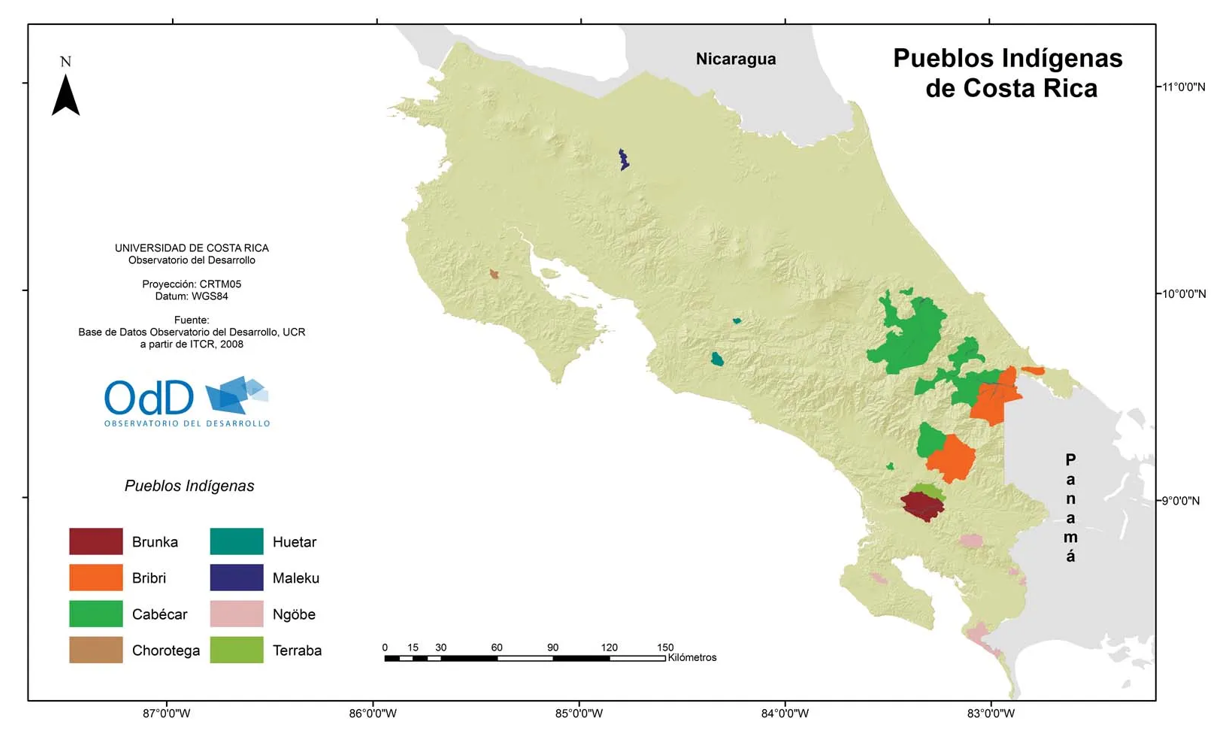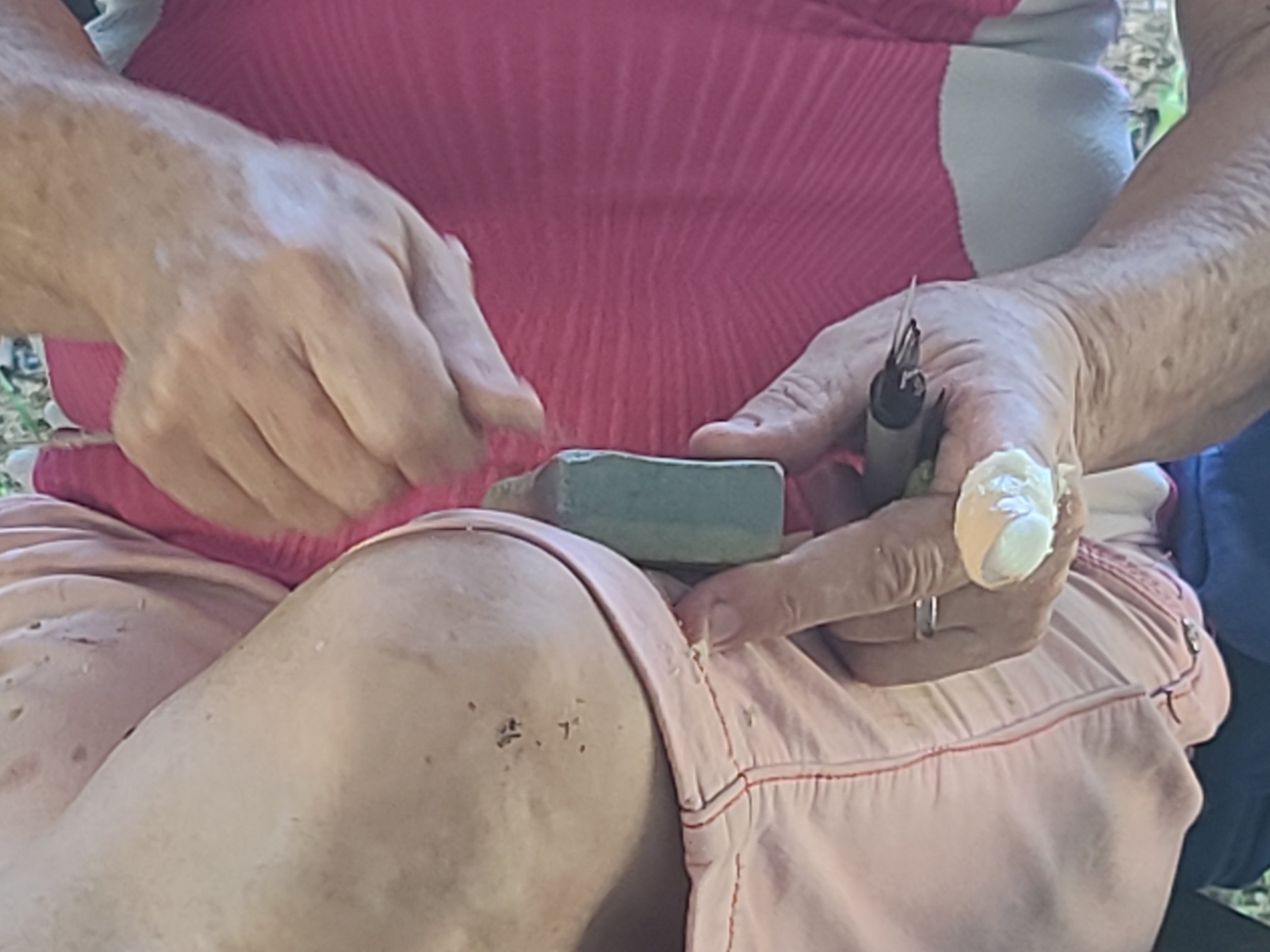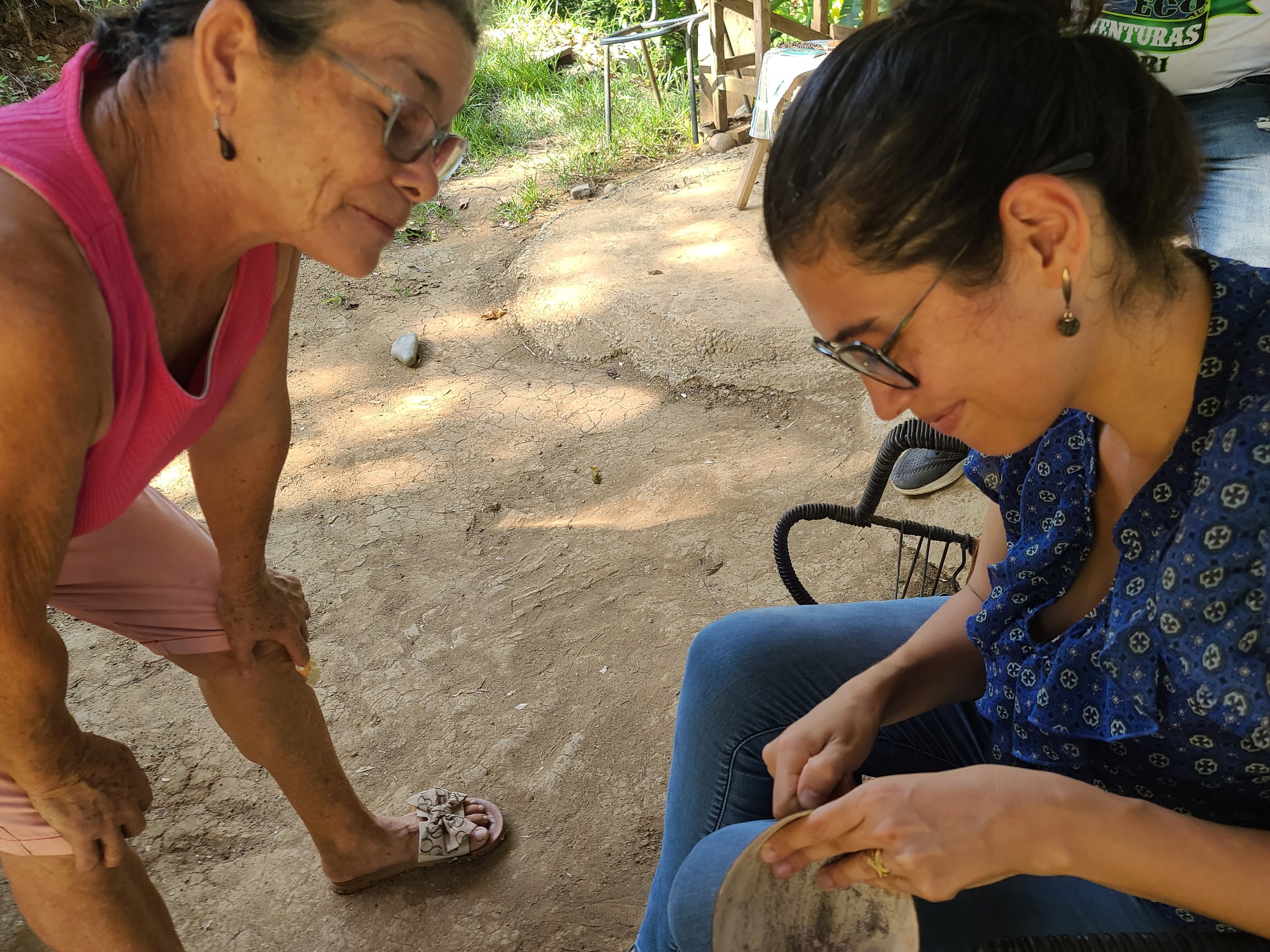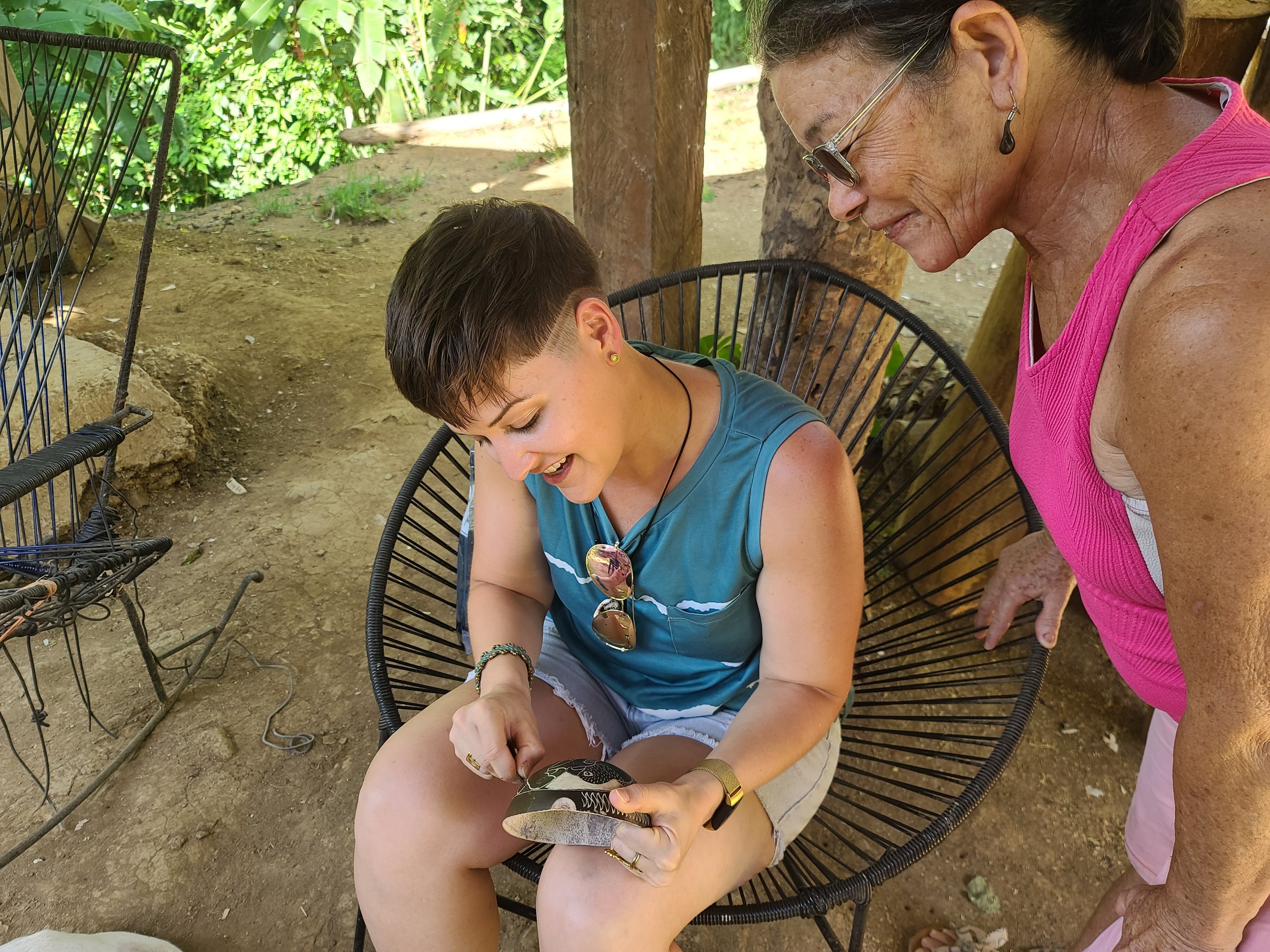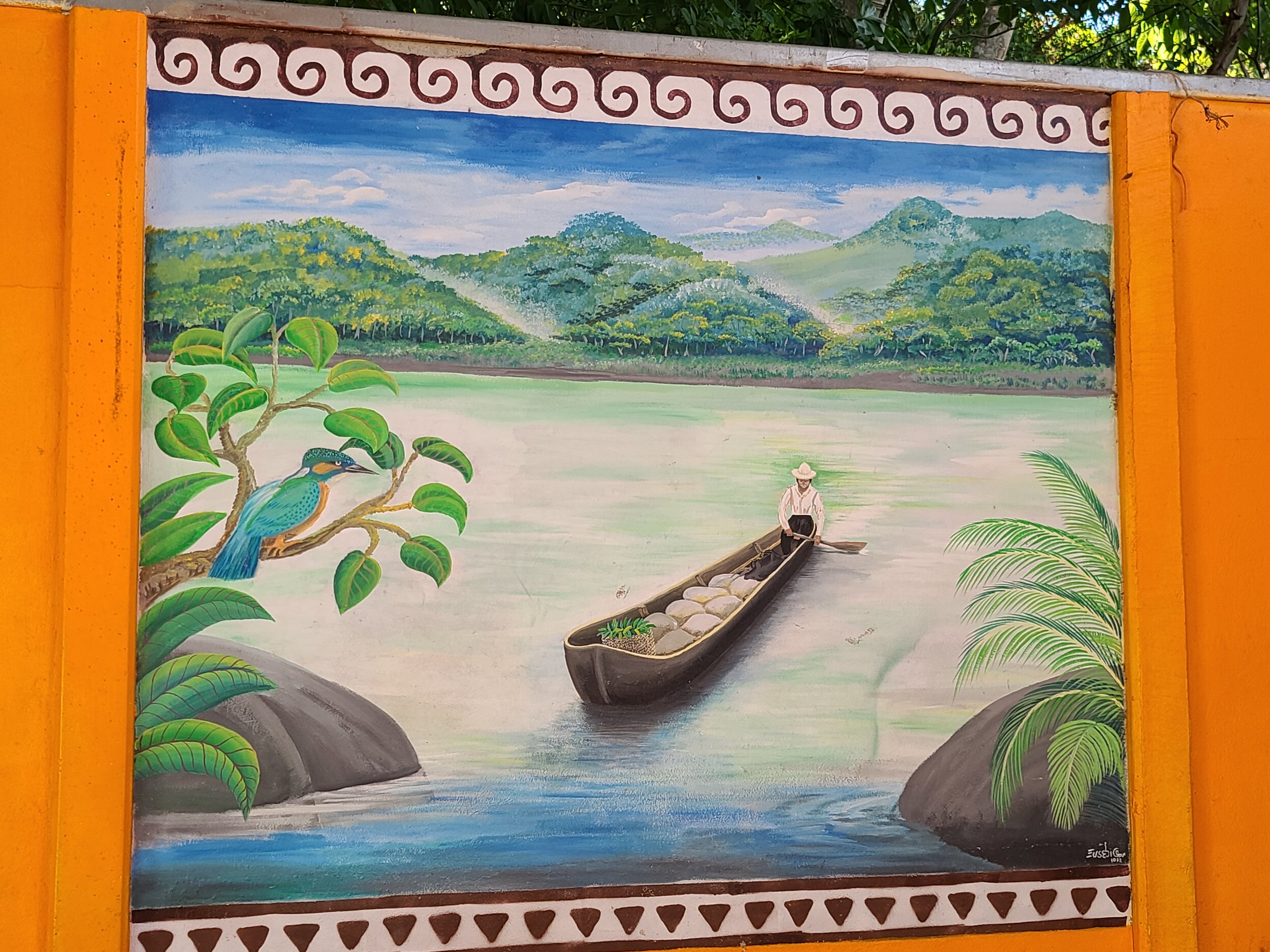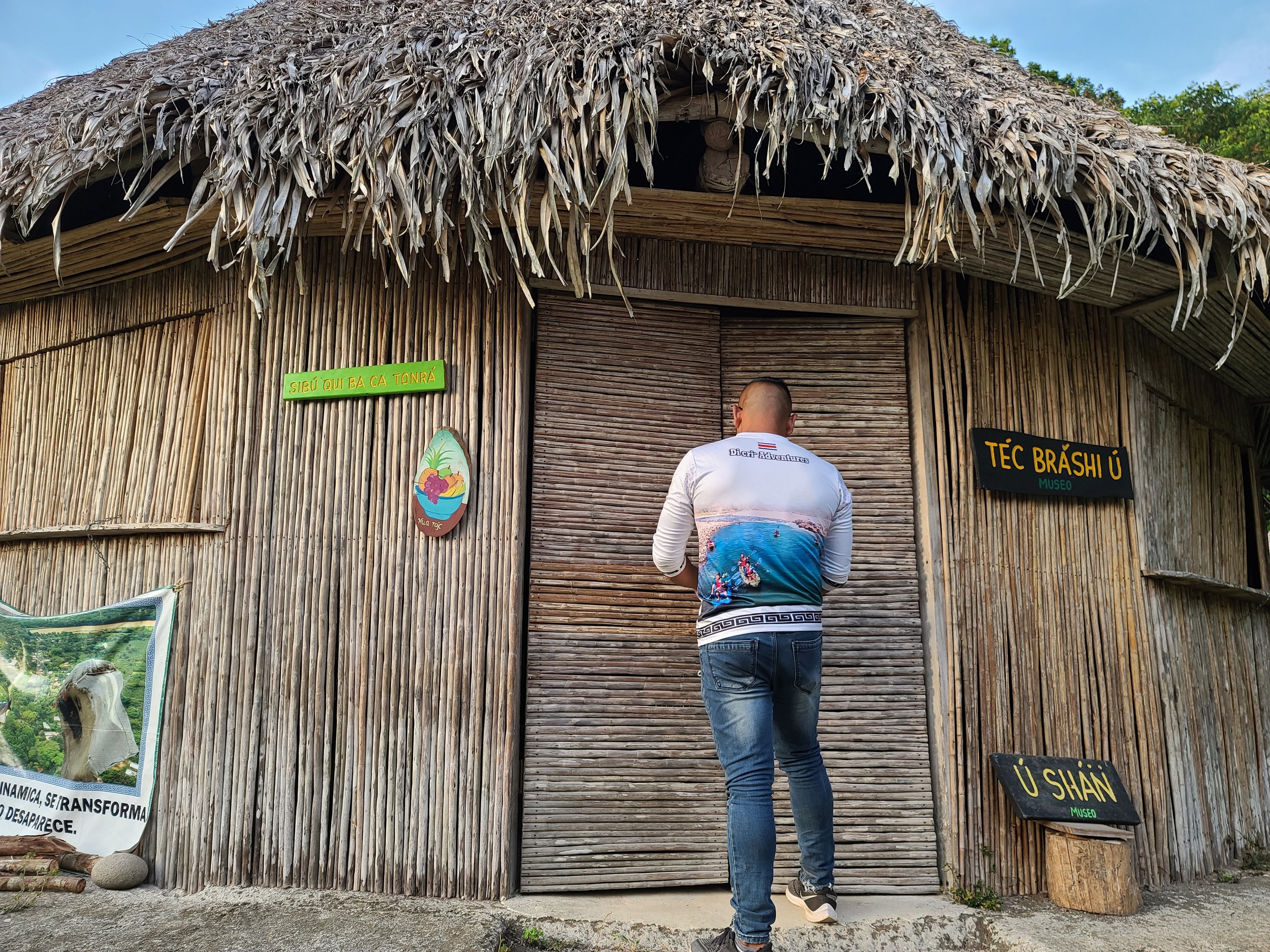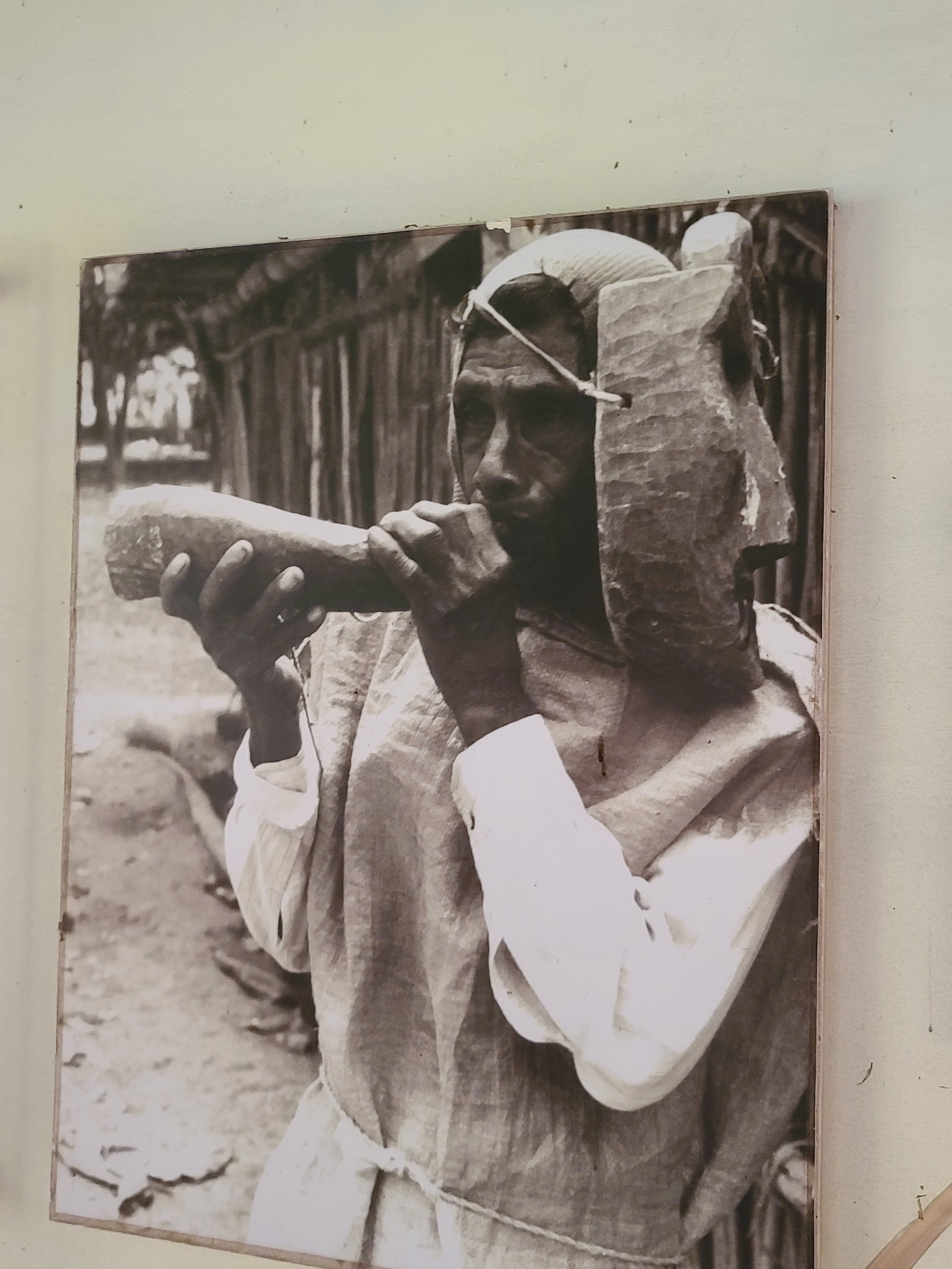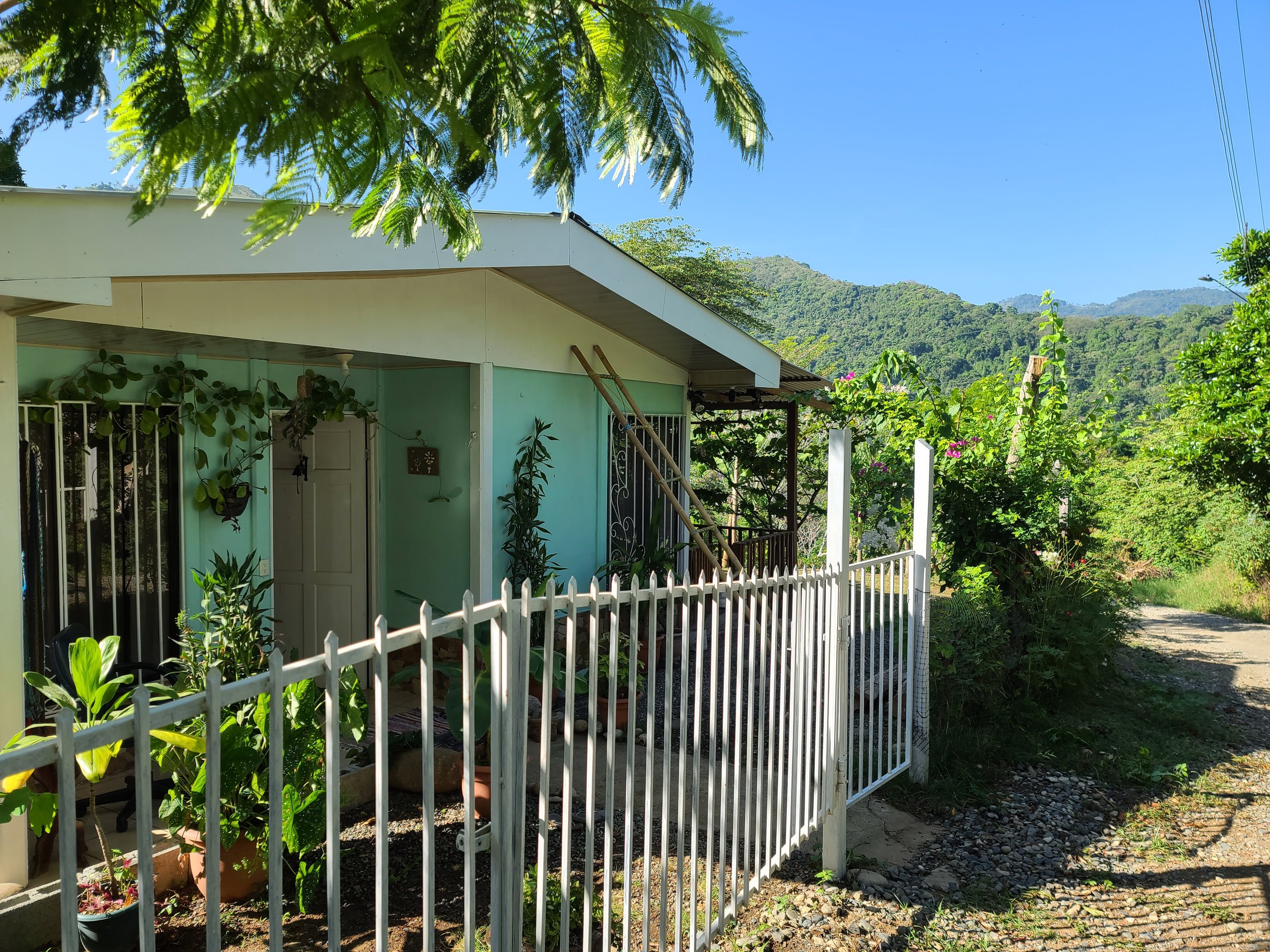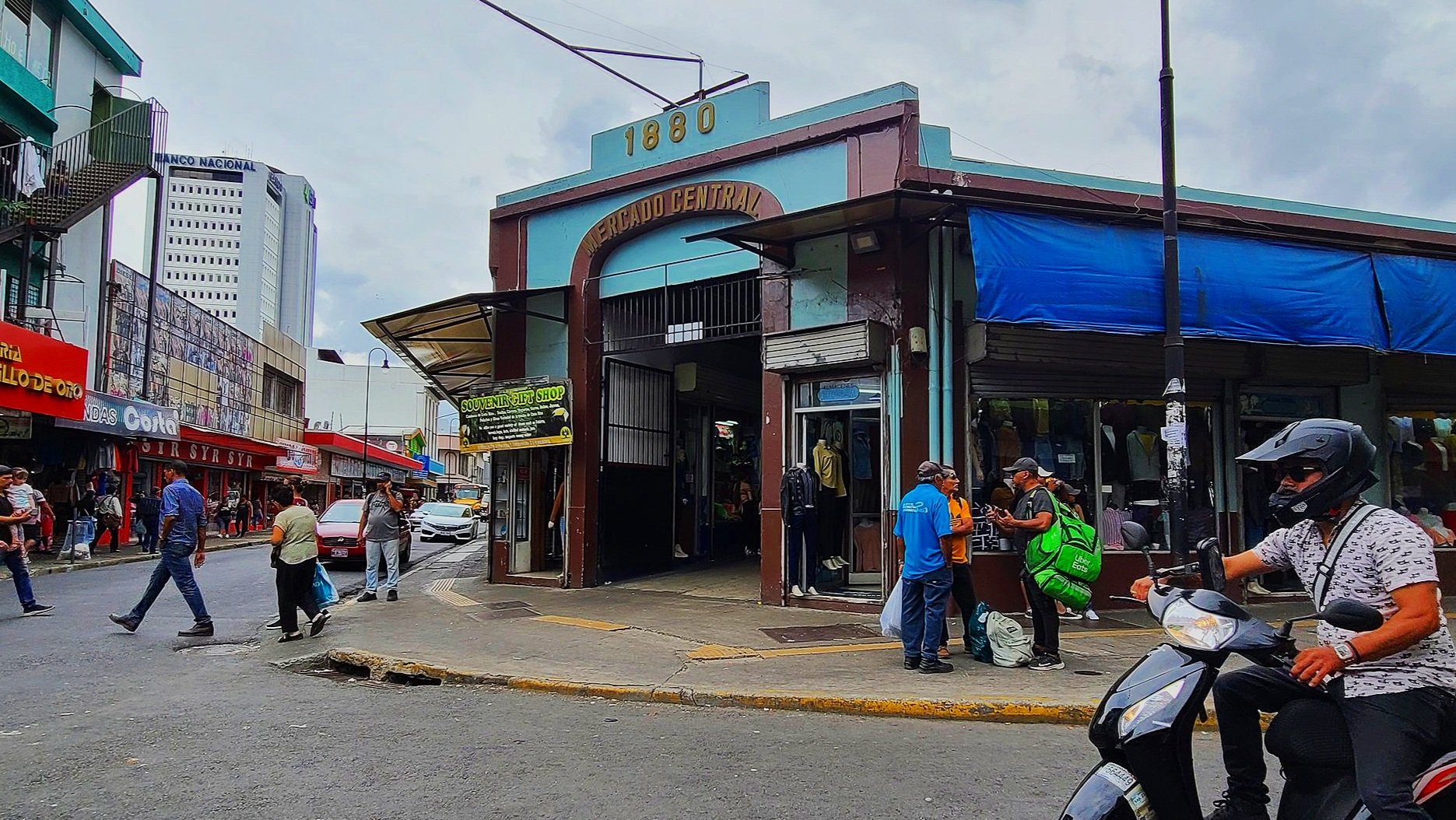My visit to the indigenous Brunca village of Rey Curré was one of the best cultural exchanges I’ve ever had in my travels. I went to learn more about the Brunca people, their cultural traditions, and their modern day struggles. I walked away with so much more!
The experience started with a 3-hour artist’s workshop with a couple who craft traditional Brunca masks among other pieces. I then heard stories depicted through paintings in their community center. After, the town museum helped illustrate Brunca history dating back thousands of years through Spanish colonization and up until modern times.
The best parts, however, were the simple conversations with all the people I met—how they formed their families, their perspectives on life in Rey Curré, and their efforts to protect their culture from further colonization. The food I ate and trinkets I walked away with were icing on the cake! I had an amazing time and I hope to be back again to experience their famous New Years festival one day!
Who Are The Brunca People?
I had it in my mind to try to connect with the indigenous people of Costa Rica long before I traveled there.
I have been making a greater effort before I travel (especially across the Americas) to learn about the original stewards of that country’s land. I want to make a better effort to see who may still be there and learn ways I can spend my money and pay respect to the indigenous peoples who still live there.
So, before I traveled, I looked at native-land.ca and did some research on the 8 remaining indigenous tribes of Costa Rica: Teribe, Guatuso, Bribri, Huertar, Chorotega, Ngabe, Cabecar, and Brunca
The tribe that stood out to me in my reading was the Brunca. The locals I stayed with spelled it Brunca so that is how I will, too, but they are sometimes also called Brunka or Boruca.
Not only were they the original peoples of the Osa Peninsula, where I would be beginning my time in Costa Rica, but they were also iconic for their mask crafting and New Years festival. For these reasons, I decided to find a way to get in touch with them.
How Did I Connect With The Brunca People?
Before I traveled to Costa Rica, I put an ad up on couchsurfing.org to let locals know about my planned visit. You can read more about how couchsurfing works here and here on my blog. Generally, it’s kind of like Airbnb but without paying your host for a stay—as it is based on a cultural exchange. There is a similar referencing system, too, so you don’t have to stay with anyone who hasn’t been seriously vetted.
I put an ad up to get tips from people and also see if anyone may be available to host. Most hosts were located in San Jose, the capital city. I didn’t plan to spend much time there so when people reached out I mostly asked for tips on the rest of the country.
One tip I asked for was about how to stay with the Brunca. That’s how I connected with Daniel from San Jose. He went to university with Paul Lazaro whose relatives still live in one of the Brunca villages on a reservation. He connected me to Noel who only spoke Spanish via text. While I was in Drake Bay, I texted back and forth with Noel with the help of Google Translate and even Linch helped a bit at one point over a phone call!
Eventually, we came to an agreement on a price ($90) and activities for my stay. I could tell from his responses that my request was already a bit unusual. He couldn’t seem to understand that I just wanted to learn about his people and that I didn’t need fancy accommodations. Nevertheless, he seemed more than willing to put together an itinerary and he told me where and when to meet.
This is what the itinerary included: 2 meals, homestay overnight with a Brunca woman, translator, artist workshop, museum visit, community center visit, and more.
Getting To Rey Curré
It was 2 hour drive from Drake Bay to the Brunca reservation. At first, I followed a google map designation which took me along the Rio Grande de Terraba. I would later learn the significance of this river to the Brunca people!
A sign pointed me a dirt road. This looked right to me with the text describing the Brunca 8km up the road. The road climbed upward in elevation the further I went.
Along the way, I stopped to check out the views of the valley and mountains below.
This area was absolutely gorgeous and appeared to be filled with all native plants and untouched landscape. Beyond the mountains in the distance, the road would turn downward into a valley where there was a Brunca village.
I texted Noel when I arrived but I learned that I made a wrong turn. This was the wrong village!
This Brunca village was the more touristy village of the two in the area. Instead, I was meant to go to the village in Rey Curré—the river people rather than the people up in the mountains.
The people in the mountain village of Boruca went there long ago, moving from the river region and deciding to stay in the mountains. Thus, this established two separate villages which, today, have some amount of rivalry between them!
I turned right around and went back down to find Noel and his sister-in-law Jahel in Rey Curré. They met me outside Noel and his wife’s home. They immediately offered me some fresh watermelon and told me that we would depart as soon as I was ready for the first activity on the itinerary. I was ready!
Daymar Artist Workshop
Noel and Jahel got into Lucia (my 2-week car rental) and I drove us down the road less than 2 minutes. They had me pull off to the side in a least expected spot. I wasn’t sure there was even anything there until I saw it—a little wooden hut set up in a clearing in the forest set back about 25 feet from the road.
This is where we found Daymar—a traditional Brunca artisanry workshop business. Daymar is a portmanteau of the business owners’ names: Daysi and her husband Margarito. This is a family-run business with mainly Daysi and Margarito crafting everything but sometimes their children help with painting or designing some of the crafts and the children also help their parents promote their work on social media.
Daysi is a native Costa Rican but she fell in love with and married Margarito who is Bruncan. She told me a story that her family kicked her out when she was 15 years old when they found out she was in love with an indigenous man because of their racism toward the Brunca people. Daysi and Margarito have been married for 46 years.
Costa Ricans often think of the Brunca as the devils depicted in the masks they create and that they do witchcraft. But she knew better and didn’t care because she loved Margarito and she loved the Brunca people. Daysi learned their traditional craft and she now carries forward their traditions in her art and workshop facilitation.
Margarito primarily carves masks and Daysi carves and paints masks and crafts all sorts of other items using both traditional Brunca methods and materials as well as some modern methods and materials.
The most sought-after items by tourists are the masks. There are 3 different types of designs: (1) the traditional diablo mask, (2) the mask with diablo and ecological designs, and (3) an ecological mask depicting only nature and animals which is not traditional but for selling to tourists.
My favorite was the traditional diablo masks. Below is a photo of Margarito showing the masks to me in their various stages. The finished mask is a photo I got from their Instagram page. I got so absorbed in the workshop that I forgot to take a picture of a finalized mask!
These masks are really important to the story of the Brunca people’s history and culture. While from the outside the Diablo masks can seem “scary,” the Brunca perceive these masks as symbols of well-being. They also offer protection from evil spirits.
Another traditional item they craft are water carriers. Daysi uses bark from the Balso tree to make twine for carrying and hanging them. She showed me the technique for getting the bark off in the correct way to be able to use it as twine.
Daysi also showed me how she hollows out Jicaro tree fruit and then carves modern designs into them to make them more attractive to sell to tourists. Otherwise they were traditionally plain on the outside, used for practical water carrying purposes only.
Daysi showed me her toolset—mostly make-shift knives made out of random handles and sharpened pieces of metal she’s put together. But she needed her tools to be very sharp in order to do her work. She demonstrated sharpening them on a whetstone and emphasized pointing the knife away from your body as you work.
At the start, however, Daysi slipped and cut her pointer finger. I ran to my car to fetch some of my first aid kit materials for her—some gauze and a band-aid. I was glad I had those materials packed—a part of my every trip packing list!
Below is a video showing various parts of the workshop in which Daysi showed me all of these techniques and more, including mask-carving.
Both Noel and Jahel were there with me the whole time. Otherwise, this was a totally personal, one-on-one workshop with Daysi and Margarito carving a new mask in the background.
Jahel helped translate the Spanish and English for us. But Jahel also joined in the workshop and tried carving, too.
I also got to try carving into the Jicaro fruit. She left it unfinished for me and told me I could take it with me to finish on my own after the workshop. It’s a great souvenir to have something that she started and I helped etch into for the workshop.
Daysi said I was surprisingly very good. She joked that she may need me to stay to help her! :)
I was not as good at the mask carving, however. It was really challenging!
In my research, I learned there are only five women in the community who carve masks, as it is traditionally a role for men. It’s pretty cool that I got to meet one of them!
Daysi is really creative and a true artist. She comes up with new ideas for things to create from the traditional materials and methods all the time. One of these creations is a design she described to me in great detail—a doll. She described having to brain together over 200 strands of twine from the bark just for the hair!
Jahel told me we could see one of them at Noel’s home later. I took a photo which you can see below. It’s so detailed and beautiful!
I really enjoyed talking to Daysi and Margarito during this workshop. It lasted almost 3 hours and I was able to ask them about their lives, their relationship, the community, their family, and more. It was a real cultural exchange as well as a really cool experience to see their designs come to life in the moment.
Before leaving, I decided to buy a couple of items from their shop—a diablo mask necklace ($18) and a little carved jaguar head ($10) as a souvenir for a friend. Daysi then offered me to take any turtle carving I wanted for free, which was incredibly generous. So I walked away with 4 total souvenirs from this workshop!
The additional diablo mask pictured below next to the turtle is a part of a story that comes up a bit later in this post!
Community Center Storytelling
Next, Noel and Joel directed me down the road to a different turn off. We were going to the Yímba ú Cri^é community center. Noel got out a key to open up the center. This is when I started to understand better Noel’s connection to this community. He had a key to this place? He seemed important to the community all of a sudden and my assumption was correct.
We walked inside and the walls of the community center were lined with various paintings depicting different aspects and stories surrounding Brunca culture. The artist behind the painting happens to be Noel’s relative!
We walked for image to image, Jahel telling the story behind each painting, translating from Noel filling in some more knowledge for her. She spoke about various myths and symbols of the community in the plants and animals in the area. She noted the different food and materials used by the women in the paintings.
Several of the paintings depicted the famous masks and she told the story of the Danza de los Diablitos (Dance of the Little Devils). This is a festival that takes place for 3 days around New Years Eve every year. Many tourists now come to participate in it, too. The community center is the site of this festival in Rey Curre.
The festival represents the Brunca people’s war with the Spanish Conquistadors. The festival involves a lot of drinking and dancing while wearing the masks over several days. One person dresses up as a bull to represent the Spanish. There is struggle between the diablos and the bull but ultimately the Brunca triumph over the Spanish which represents the continuation of Brunca culture despite Spanish colonization.
The festival is what drew Jahel to the Brunca people initially. She stayed when she met a Brunca man and fell in love with him. Now she is with Noel’s brother and they have a son together.
One of my favorite paintings in the place depicts two Brunca looking at each other across a mask. Jahel explained this shows the Brunca people’s respect for the past—the history and traditions of their people—while embracing modern life and the changes to their culture. The traditional, unpainted mask and Brunca wearing the headband on the left represents the past and the painted mask and Brunca person on the right represents the present.
Several of the paintings depicted the Rio Grande de Terraba. Jahel emphasized its importance to the Brunca people for agriculture and transportation. The river helped them both historically and present day.
However, Jahel also mentioned there is currently a government initiative to get a power plant built up the river. The Brunca people are fighting this because they know it will pollute the river and the land. And it would break agreements they have on the reservation.
Article III of the Indigenous Law of Costa Rica explains that non-indigenous people cannot rent or buy land and farms on the reservations. Regardless, much of the land is not owned by the Brunca people. In Rey Curré, only about 23% of the land is owned by the Brunca.
In private, Jahel shared with me some of what she views as some of the sad challenges of the Brunca people. In addition to dealing with external struggles like with the power plant, they have internal struggles as well. They are what you might imagine as they reflect the struggles of many indigenous people globally as a result of colonialism, capitalist influence, the stripping of their culture, and discrimination both interpersonally and systemically.
I really wish more resources and support as well as land was given back to indigenous communities worldwide.
The Museum & Other Curiosities
The next stop on our tour was the community museum. They explained this museum was just recently built. They moved it farther away from the river just in time before a storm came and would have flooded it. But they are considering moving even further from the river in anticipation of the storms getting even worse.
Noel let us into this building, too.
Inside is where I learned more about the more recent history of the Brunca people in Rey Curré. This included information about Noel’s father. His father was a chief in the village and was a major part of revitalizing the community and building back up their culture and economy. As a result of being a leader, Noel is now looked to and seen as a leader in the community.
So Jahel confirmed for me that Noel is really the guy in Rey Curré. I felt especially honored now to connected to him and a part of this tour with him leading the way.
Noel showed me a woven basket in a canoe inside the museum. He held it up and said he remembers riding through the village in the basket on the back of a cow with his father! He was so small he could fit in a basket that size! :)
A bit difficult to see, Noel’s father is on the tractor in the image below. His father did a lot to fix up the community to where it is today and Noel is continuing in his footsteps.
Some of the information on the posters in the museum was about the traditional New Years festival. Boys 14 and up were the main participants as the “diablos.” They also recycle the bull costume that one person wears each year. It is kept in the museum year round. At the end of the festival, they traditionally burn the whole costume except for the bull mask but it seems in Rey Curré they keep the whole thing for reuse.
Outside of the museum, Noel stopped at a big round boulder to tell a story about it. Apparently, these stone spheres a Costa Rican are a bit of a mystery. Over 300 petrospheres were found in the Diquis Valley which is one of the traditional regions of the Brunca people on the Osa Peninsula. These spheres were taken by colonizers and the government, bought by wealthy people and placed in national museums around the world. The Brunca were able to get a few of them back but not all.
There’s disagreement about what they were used for and how they came to be. Some believe they are related to the stars, others say they marked chief’s property. Some believe they are from the lost city of Atlantis. Whatever they were used for, the Brunca people deserve to keep and preserve all that was once theirs. I hope they are able to acquire all of them back.
Next, we drove a bit deeper into the center of one of the villages. This was a narrow path we took that wasn’t even really a road. But I parked and then we walked between people’s homes and backyards until we reached a sloping stone wall.
Noel explained that this wall was studied by archaeologists. They said it is evidence of this area being populated by ancestors of the Brunca people as far back as 1500BC. This information is clearly very important to Noel and the community, as it represents their rights to the land as their traditional homelands dating back thousands of years.
A Cultural Exchange
Back at Noel’s home, his wife cooked dinner for us and breakfast the next morning. We sat and talked for a while during both meals about lots of different topics. This was one of my favorite parts of the experience—we had a true cultural exchange.
And Jahel brought her son who entertained us between the serious bits of conversation.
We discussed lots of topics related to the Brunca people. I also told them about the indigenous people in the USA. Specifically, I asked them if they had a similar variation of two-spirit people. They don’t, so this led to a very interesting conversation about the importance of two-spirit people to the traditions of many tribes in the USA. I mentioned how colonization in the USA tried to get rid of two-spirit people but that they persist today, too. Explaining who two-spirit people are seemed to blow Noel’s mind a bit but he was really interested to hear it and so was Jahel!
They were also very curious about me and they wanted to know why I wanted to do this tour. Jahel explained that they sometimes get volunteers from Germany. They stay for long periods of time as a cultural experience through school but they are young and seem to be really surprised to learn that they all live very modern lives (hot, running water, plumbling, etc.). I told them that was pretty embarassing that the students didn’t realize this ahead of time.
I explained that I wanted to experience this tour because it’s important to me to understand the country I am visiting not just from the descendants of those who conquered it but from the people who were there for much longer. I told them I believe in traveling as ethically and consciously as I can—that I want to spend at least some of my money where it will make a positive impact on indigenous communities. And I wanted to have a chance to write about this to encourage others to do the same when they travel.
After sharing some of this with them, Noel walked away from the table and then came back with a cloth. He unfolded it and revealed 4 tiny mask carvings on strings. He said, “Pick one!”
I was surprised at this. “Really?” He told me they were carved by the same artist from the community center. “Wow, this is really special! Thank you!” I took the one he laid closest to me.
“It will offer you protection.”
I was truly touched by his generosity. I ended up wearing this necklace for much of the remainder of my trip and its now a favorite piece in my jewelry collection!
If that wasn’t already enough, what would a cultural exchange be without food?
As a foodie, I really believe you can get to know a place the best through its food. Different from the rest of Costa Rica, this was a great opportunity to try some of the traditional indigenous foods of the Brunca people.
For dinner, Noel’s wife served carne ahumada which was seasoned and smoked pork with a side of vegetables, plantain, and a tortilla, served on a bijagua leaf.
In the morning, they served cacao with milk and tamales wrapped in bijagua leaf.
These tamales were prepared using rice. They are traditionally only served on special occasions and when guests visit, so it was a real honor to try them.
I ate one and then they asked if I wanted another. When I said no, Jahel seemed surprised. Only for that reason did I have a second. I didn’t want to ask for too much but it seems very normal to eat multiple tamales at one meal! I was very glad to have another—they were so good and I knew I had a long drive ahead.
Before I left, I said goodbye to my homestay host—Noel’s sister! She lived right next door in a nice, air conditioned home with a beautiful little guest bedroom. I was super comfortable staying there and had a great night’s rest. She served me tea in the morning when I mentioned to her my throat was a bit sore. And she told me all about her daughter who is living in Seattle now.
The next photo is the outside of her home looking down into the village toward the river.
The night before, I made sure to get a quick selfie with Jahel—my wonderful translator for the duration of my stay. She was so nice and I feel that we would become good friends if I had more time there.
Before I left, Jahel took my down to the river. I asked to see it more closely especially because of the significance it has to the Brunca people.
Noel also offered for me to take a kayak trip for an extra fee if I wanted. I couldn’t spare the expense or the time in my itinerary. I was also very satisfied with not turning this part of my trip into an adventure. I wanted to keep it purely educational. Although, after learning about how important the river is, I feel kayaking it would be another great way to connect with the Brunca people and their culture. So that was my motivation for at least dipping my feet in the river before I departed!
On my way out, Jahel recommended that I go to the hospital in the next town instead of going to a physician’s office. My throat was definitely acting up, another reason why I turned down the kayak tour. I would later be very grateful for her recommendation!
In Conclusion
Visiting the Brunca people of Rey Curre was an incredibly special experience. For $90 I feel like I received so much more that is truly priceless in these types of exchanges. They were so kind, forthcoming, answered all my questions, took interest in me, were amazing hosts, incredibly generous, and provided so much enriching information about their life, people, culture, art, and more. I just want to thank them, from the bottom of my heart, for inviting me in and teaching me!
I walked away feeling like I had just uncovered a secret. One that, to be honest, I selfishly want to keep to myself. But in the end, a major motivating factor was to share it here on my blog. I hope it inspires others to reach out to set up a similar experience wherever they travel. If that’s Costa Rica and you’d like to get in touch with the Rey Curré Brunca people for a tour, I can put you in direct contact with Noel. Reach out to me (rikka@deviatingthenorm.com) and I’ll be happy to share his information with you. Then come back here and comment about your experience!
One day, I hope to return to their village—maybe I’ll go one day for New Years to experience Danza de los Diablitos!



